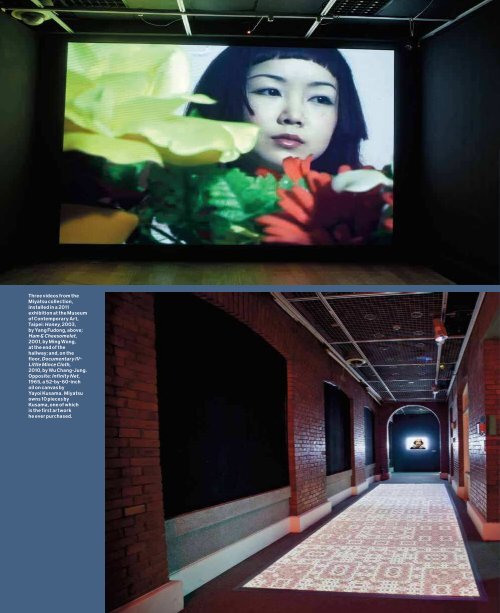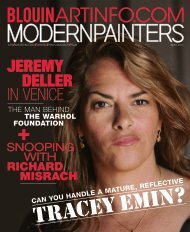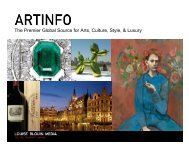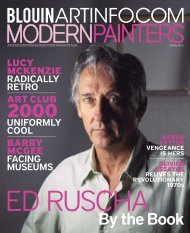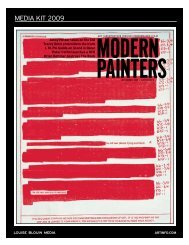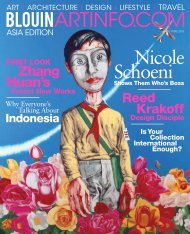Linke - Artinfo
Linke - Artinfo
Linke - Artinfo
Create successful ePaper yourself
Turn your PDF publications into a flip-book with our unique Google optimized e-Paper software.
Three videos from the<br />
Miyatsu collection,<br />
installed in a 2011<br />
exhibition at the Museum<br />
of Contemporary Art,<br />
Taipei: Honey, 2003,<br />
by Yang Fudong, above;<br />
Ham & Cheesomelet,<br />
2001, by Ming Wong,<br />
at the end of the<br />
hallway; and, on the<br />
floor, Documentary IV-<br />
Little Mince Cloth,<br />
2010, by Wu Chang-Jung.<br />
Opposite: Infinity Net,<br />
1965, a 52-by-60-inch<br />
oil on canvas by<br />
Yayoi Kusama. Miyatsu<br />
owns 10 pieces by<br />
Kusama, one of which<br />
is the first artwork<br />
he ever purchased.<br />
YaYoi Kusama studio inc. and ota Fine arts, toKYo. opposite, From top: Yang Fudong, shanghart gallerY, shanghai, and moca,<br />
taipei; ming Wong, Vitamin creatiVe space, guangzhou, Wu chang-jung, project FulFill art space, taipei, and moca, taipei<br />
Blouin<strong>Artinfo</strong>.comAsiA | mARch/ApRil JANUARY/FEBRUARY 2013<br />
2013<br />
companies offering financing to all comers,<br />
and his wife knew he was just mad enough<br />
about art to go into debt. One day she called<br />
him and asked that he hurry to the family<br />
home, where she was waiting with his mother<br />
and grandmother. To keep him out of the<br />
clutches of loan sharks, they had pooled their<br />
funds to advance him the money he needed.<br />
In 1998 Miyatsu had the pleasure of lending<br />
the painting to the first major Kusama<br />
retrospective, which opened at the Los<br />
Angeles County Museum of Art, subsequently<br />
traveled to New York’s Museum of<br />
Modern Art and the Walker Art Center, in<br />
Minneapolis, and finally arrived at the<br />
Museum of Contemporary Art in Tokyo.<br />
Seeing the painting hanging in a museum in<br />
the capital, his family finally conceded<br />
that perhaps he wasn’t so crazy after all.<br />
“I am very lucky,” Miyatsu reflects.<br />
“I started my career with Kusama. And then I<br />
began to meet artists of my generation, like<br />
Olafur Eliasson and Nara. Now they are very<br />
established, but 15 years ago they weren’t.<br />
They were just emerging—cheap but very<br />
interesting. It is a very special generation.”<br />
With these artists he established a pattern<br />
of building a network of relationships through<br />
his collecting. “For me it’s very important to<br />
communicate with artists as well as to collect<br />
them,” he explains. “One of the very big<br />
charms of contemporary art is that I can<br />
communicate with each of the artists I’ve<br />
collected, from Kusama to the youngest ones.<br />
If I wanted to talk to Vermeer, for example,<br />
I couldn’t do it. So every art work I own is<br />
attached to a memory and a communication.”<br />
Miyatsu has never sold a work, and<br />
he continues to finance his collecting with<br />
his salary. In recent years he has become<br />
interested in the younger generation<br />
of Taiwanese artists, and in video and new<br />
media in particular. His collection of the<br />
latter is particularly strong and includes<br />
work by Cao Fei, Takagi Masakatsu,<br />
Weerasethakul, and Yang Fudong. During<br />
Art Show Busan 2012, the Asia-Pacific<br />
contemporary fair that debuted last June<br />
at the Korean city’s just-opened convention<br />
center, Miyatsu presented a focused<br />
exhibition of 20 new-media works by<br />
Asian artists from his collection.<br />
We talk about all this in the welcoming<br />
living room of his house, facing walls<br />
of books and catalogues from which<br />
he constantly selects volumes to point out<br />
the works of artists he admires. Even in this<br />
casual setting, almost every object<br />
possesses an artistic pedigree, including the<br />
bookshelves, which were designed by<br />
conceptual artist Taro Shinoda and inspired<br />
by the shape and color of the packing crates<br />
that have delivered many artworks to<br />
Miyatsu’s door. The curtain that hangs across<br />
the room’s window tells a more intimate<br />
story. It was created by Nakagawa Sochi,<br />
a group of Japanese fashion designers who<br />
are inspired by the possibilities of recycling<br />
old clothes, in collaboration with Hong<br />
Kong artist Lee Kit. The materials they<br />
worked with were gathered from members<br />
of Miyatsu’s family, all of whom were asked<br />
to donate something old and well-worn.<br />
An ongoing project, the curtain is like<br />
a portrait of the collector’s extended family<br />
rendered in vibrant Japanese fabrics.<br />
Miyatsu tells me this is not the only part of<br />
his home to incorporate traces of his family.<br />
In the simple garden created by his friend<br />
Shimabuku are a weathered stone lantern<br />
and some stones salvaged from the garden of<br />
his grandparents’ old home. The idea was<br />
Shimabuku’s: He went with Miyatsu to<br />
search for what remained of the old house,<br />
and although the original was long gone, they<br />
found some fragments for the new garden.<br />
“You know, there is something egotistical<br />
about being a collector,” he tells me at<br />
the end of the day. “And that is why it is my<br />
responsibility to keep the collection safe<br />
in storage, so that one day it can be passed<br />
on.” But for Miyatsu the “dream house”<br />
is a different matter. He is happy to see signs<br />
of wear appearing around the place, even<br />
as it remains unfinished, because although the<br />
house is undoubtedly a work of art in itself,<br />
it is all the better for being lived in and loved.<br />
79


